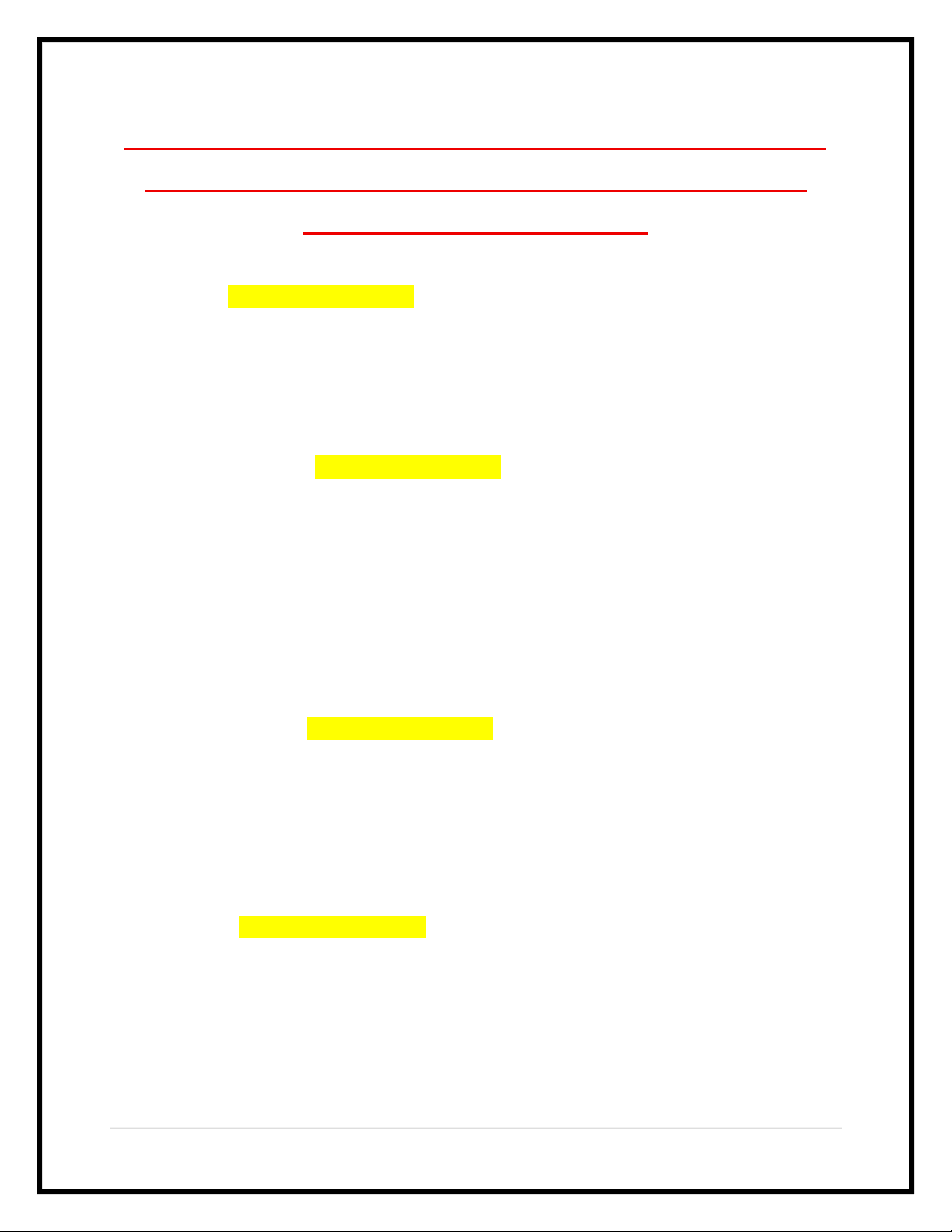
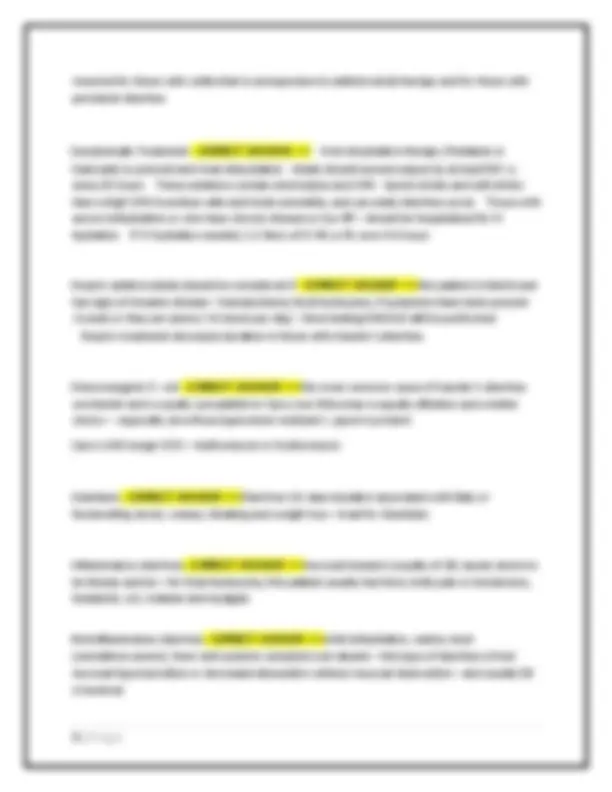
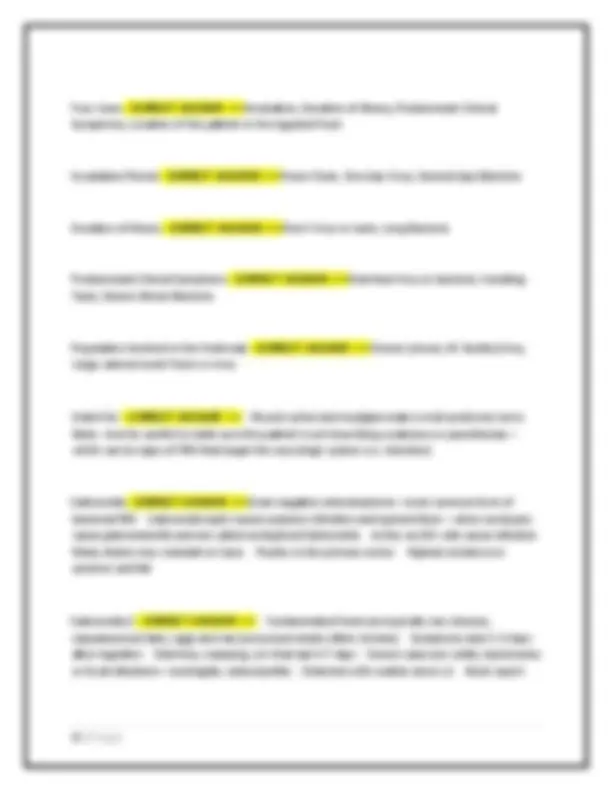

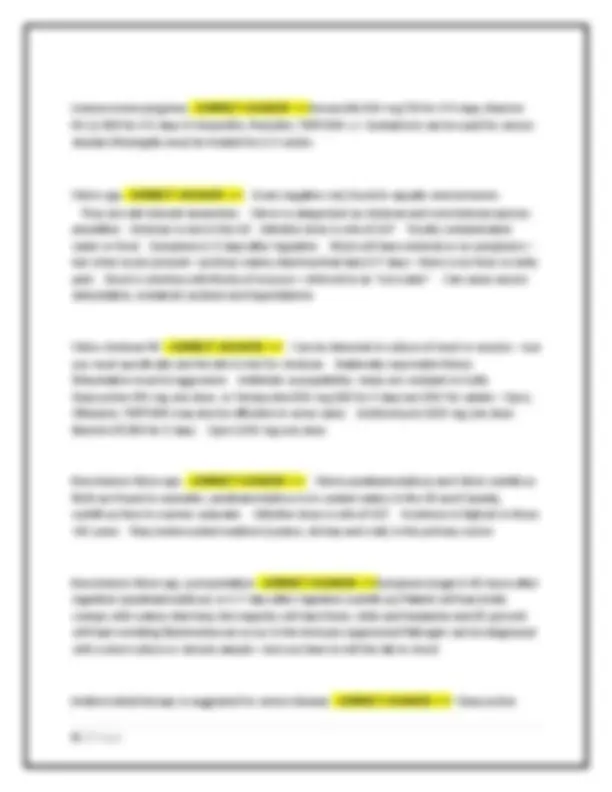
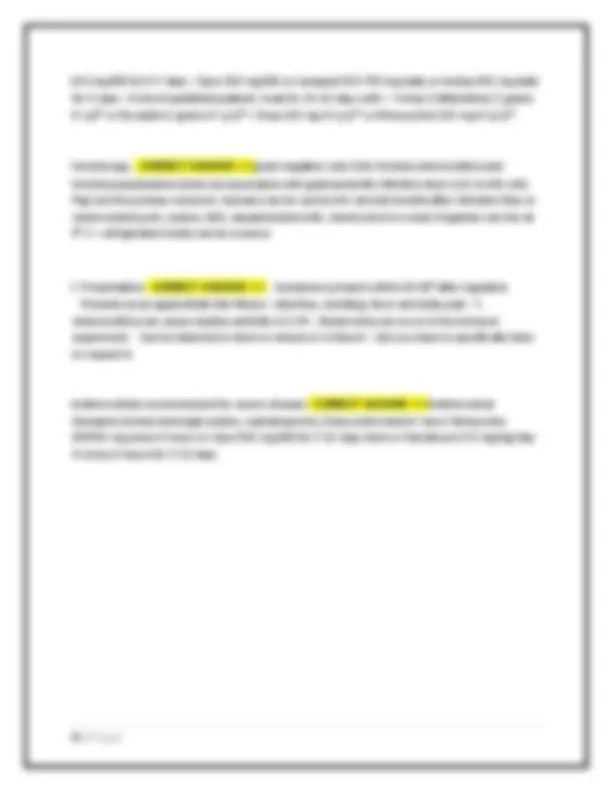
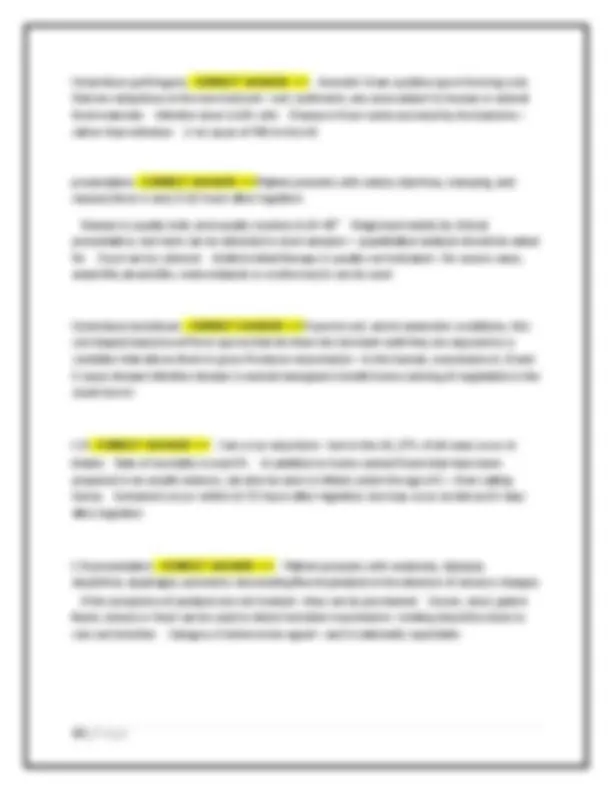
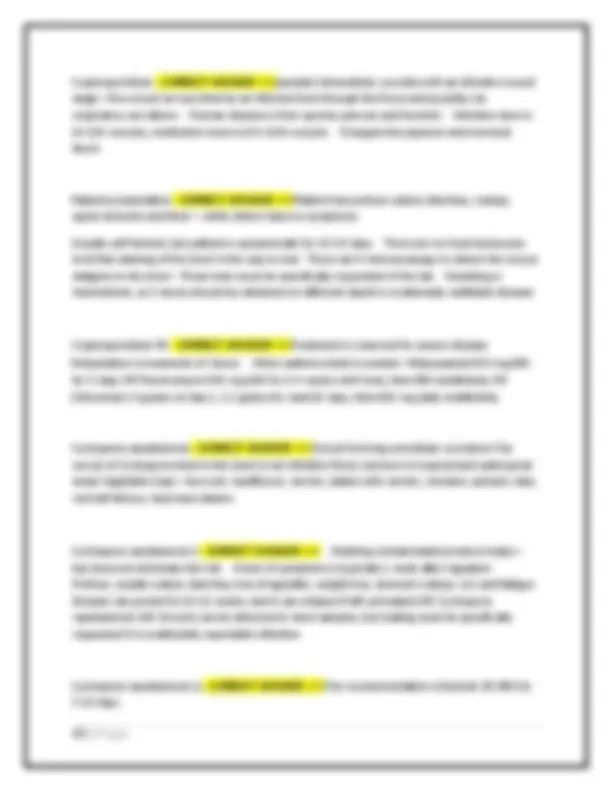
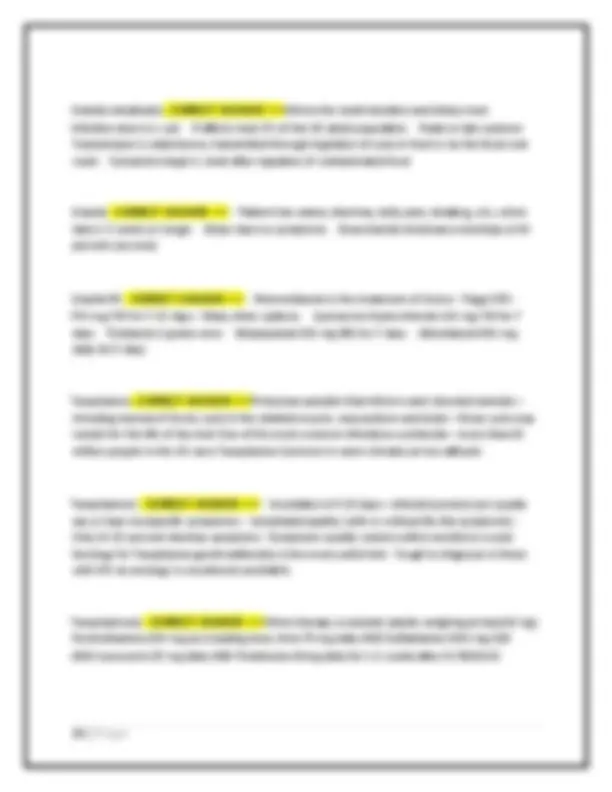
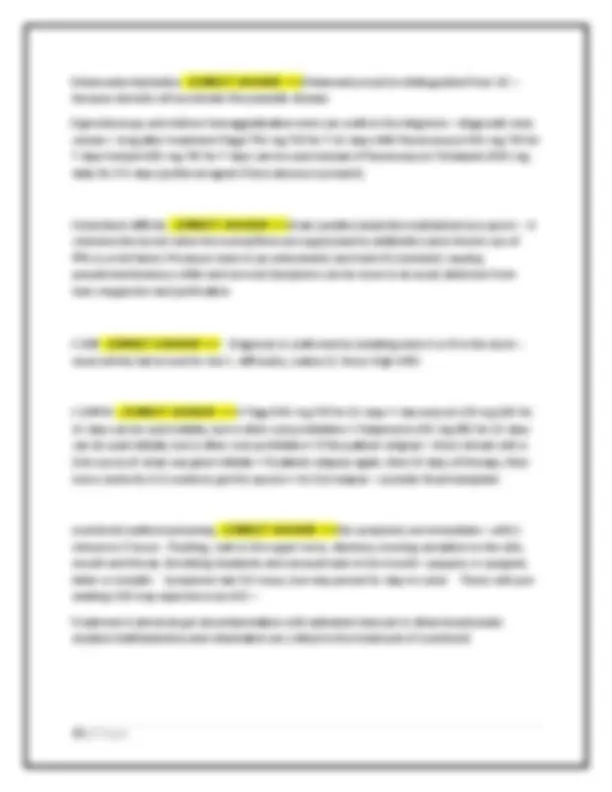


Study with the several resources on Docsity

Earn points by helping other students or get them with a premium plan


Prepare for your exams
Study with the several resources on Docsity

Earn points to download
Earn points by helping other students or get them with a premium plan
Community
Ask the community for help and clear up your study doubts
Discover the best universities in your country according to Docsity users
Free resources
Download our free guides on studying techniques, anxiety management strategies, and thesis advice from Docsity tutors
NURS 5461 GASTROENTERITIS FINAL EXAM COMPLETE QUESTIONS & CORRECT ANSWERS (WELL VERIFIED) GRADED A+ NEW VERSION
Typology: Exams
1 / 16

This page cannot be seen from the preview
Don't miss anything!










Gastroenteritis - CORRECT ANSWER >>> caused by bacterial food toxins in food- "food poisoning" In healthy adults—the s/sx usually self-limited CDC says that 1 in 6 Americans affected q yr. Can be acute or chronic (food allergy) The most common players - CORRECT ANSWER >>> —**Norovirus (1/3), Hep A, Rotavirus most common V nontyphoid Salmonella, Clostridium perfringens, Campylobacter, Staphylococcus aureus, Toxoplasma gondii, Listeria monocytogenes, Yersinia, and ***Shiga toxin-producing E. coli [aka know as STEC E. coli 0157 ] Non-Shiga toxin producing—enteropathogenic E. coli; enteroinvasive E. coli; enteroaggregative E coli and diffusely adherent E. c Epidemiology and Causes - CORRECT ANSWER >>> Acute gastroenteritis is most often from an infectious agent— food and waterborne outbreaks are important causes, fecal-oral route
Most states require reporting of - CORRECT ANSWER >>> Hepatitis A - Botulinum - Salmonella - STEC 0157 - Listeria - Shigella - Vibrio Parasites - CORRECT ANSWER >>> Parasitic protozoa do multiply in food—but can live on moist food for months in a cool, damp environment, most common transmission is contaminated water Cryptosporidium, Cyclospora, Giardia and Toxoplasma gondii are the big players Overview of the Common FB Pathogens—the Big Picture - CORRECT ANSWER >>> 60 and older—Salmonella and Campylobacter are the most common bacteria in FBD
Four clues - CORRECT ANSWER >>> Incubation; Duration of Illness; Predominant Clinical Symptoms; Location of the patient or the ingested food Incubation Period - CORRECT ANSWER >>> Hours-Toxin, One day-Virus, Several days Bacteria Duration of Illness - CORRECT ANSWER >>> Short Virus or toxin, Long Bacteria Predominant Clinical Symptoms - CORRECT ANSWER >>> Diarrhea-Virus or bacteria, Vomiting- Toxin, Severe illness-Bacteria Population Involved in the Outbreak - CORRECT ANSWER >>> Closed [school; HC facility]Virus, Large catered event Toxin or virus Watch for - CORRECT ANSWER >>> Muscle aches and myalgias make a viral syndrome more likely—but be careful to make sure the patient is not describing weakness or paresthesias— which can be signs of FBD that target the neurologic system (i.e. botulism) Salmonella - CORRECT ANSWER >>> Gram negative enterobacteria—most common form of bacterial FBD Salmonella typhi causes systemic infection and typhoid fever—other serotypes cause gastroenteritis and are called nontyphoid Salmonella As few as 200 cells cause infection Many strains now resistant to Cipro Poultry is the primary vector Highest incidence in summer and fall Salmonella 2 - CORRECT ANSWER >>> Contaminated foods are typically raw cheeses, unpasteurized dairy, eggs and raw/processed meats [often chicken] Symptoms start 1-3 days after ingestion Diarrhea, cramping, n/v that last 4-7 days Severe cases are colitis, bacteremia or focal infections—meningitis, osteomyelitis Detected with routine stool c/s Must report
Salmonella Treatment - CORRECT ANSWER >>> Routine use of antimicrobials lead to resistance and may prolong the carrier state If disease is severe and antimicrobials needed— Fluoroquinolones or extended spectrum Cephalosporins - Ampicillin, Gentamicin and Trimethoprim-Sulfa have been effective - Cipro 500 mg BID for 5-7 days; Z-pak; Ceftriaxone 1- 2 grams IM or IV for 5-7 days Campylobacter jejuni - CORRECT ANSWER >>> Gram negative rod with microaerophilic growth needs More sensitive to low pH and arid conditions than other FB pathogens 400 cells to become infected Most cases are sporadic—not part of an outbreak Unpasteurized milk or dairy products are common vectors—most cases of FB Campylobacter is from undercooked poultry or cross contamination of other foods by these items - Unpasteurized dairy, poultry and produce irrigated with contaminated water can be the source C.J. presentation - CORRECT ANSWER >>> Symptoms begin with in 2-5 days after consumption and are similar to acute appendicitis Patient may have sticky diarrhea with blood and/or fecal leukocytes, belly pain, fever, n/v, muscular pain; usually no vomiting Symptoms generally last 2-10 days Severe cases can cause intestinal hemorrhage, toxic colitis, meningitis, bacteremia, hemolytic uremic syndrome Potential long-term complications—reactive arthritis, IBS, Guillain-Barre' C.J. Rx - CORRECT ANSWER >>> Treatment is only indicated for severe disease and for those who are immune suppressed Erythromycin 500 mg BID for 5 days; Z-pak; Cipro 500 mg BID for 5 days Shigella spp. - CORRECT ANSWER >>> Highly infectious gram-negative anaerobes 4 species— dysenteriae, flexneri, boydii, sonnei—also known as groups A, B, C and D respectively Enteroinvasive in the large bowel—it is commonly mistaken for enteroinvasive E. coli Routinely—less than 500 cells cause infection and in 10% only 10 organisms cause infection Only primates harbor Shigella, fecal-oral, person to person, ingestion of contaminated food/water and fomite contamination
Hydration antimicrobials are not usually needed But remember—**STEC causes 90% of ALL HUS CBC, BUN and creatinine should be monitored HUS is unlikely if there is no hemolysis, nephropathy and thrombocytopenia 72 hours after the s/sx have started TTP—characterized by HUS, neurological changes, fever, typical affects adults 65 and older Enterotoxigenic Escherichia coli - CORRECT ANSWER >>> This species of E. coli adheres and effaces to SB Infective dose is 108 organisms This is the most common cause of traveler's diarrhea Spread through fecally contaminated food or water and infected food handlers Symptoms usually occurs 1-3 days after ingestion Enterotoxigenic Escherichia coli presentation - CORRECT ANSWER >>> Watery diarrhea for 3- 7 days, abdominal cramps, nausea, malaise; low-grade fever is not common Determining enterotoxigenic from nonpathogenic E. coli is difficult—testing for enterotoxigenic E. coli must be requested Antibiotics is not usually needed For severe illness—TMXSMX, Cipro and Azithromycin can be used - Azithromycin 500 mg on day 1, then 250 mg days 25 Cipro 500 mg BID for 3 days TMP/SMX 160/800 mg BID for 3-7 days Listeria monocytogenes - CORRECT ANSWER >>> Aerobic, gram positive usually pathogenic bacillus Resistant to freezing, drying and heat and it multiples in refrigerated foods enters the bloodstream (via gi epithelium to replicate)—it can enter the brain and placenta by infecting circulating phagocytes Infective dose is 1,000 cells Pregnant women are very high risk—the s/sx are nonspecific and diagnosis is difficult - Maternal infection can cause premature birth and/or spontaneous abortion Mortality rate from this bug— 20 to 30 percent Found in herd animals, birds, marine life; contaminated of fruits and vegetables or farm animals Raw unpasteurized milk and cheese are primary sources 10 percent of humans are carriers of Listeria Listeria Presentation - CORRECT ANSWER >>> Fever, myalgias, nausea and diarrhea Signs and symptoms begin within 9-48° after ingestion In pregnant, it presents as the flu Bacteremia and meningitis is possible Meningitis is associated with a 70% mortality Invasive disease typically manifests in 2-6 weeks after ingestion Blood, CSF, gastric washings, meconium, placenta and other tissues can be cultured for the pathogen
Listeria monocytogenes - CORRECT ANSWER >>> Amoxicillin 500 mg TID for 3-5 days; Bactrim DS [1] BID for 3-5 days IV Ampicillin, Penicillin, TMP-SMX +/- Gentamicin can be used for severe disease Meningitis must be treated for 2-3 weeks Vibrio spp - CORRECT ANSWER >>> Gram negative rod; found in aquatic environments They are salt tolerant anaerobes Vibrio is categorized as cholerae and noncholerae species pluralities cholerae is rare in the US Infective dose is cells of 107 Fecally contaminated water or food Symptoms 1-3 days after ingestion Most will have minimal or no symptoms— but when sx are present—profuse watery diarrhea that lasts 3-7 days—there is no fever or belly pain Stool is colorless with flecks of mucous—referred to as "rice water" Can cause severe dehydration, metabolic acidosis and hypokalemia Vibiro cholerae RX - CORRECT ANSWER >>> Can be detected in culture of stool or emesis— but you must specifically ask the lab to test for cholerae Nationally reportable illness Rehydration must be aggressive Antibiotic susceptibility- many are resistant to Sulfa Doxycycline 300 mg one dose. or Tetracycline 500 mg QID for 3 days are DOC for adults - Cipro, Ofloxacin, TMP-SMX may also be effective in some cases Azithromycin 1000 mg one dose Bactrim DS BID for 3 days Cipro 1000 mg one dose Noncholera Vibrio spp. - CORRECT ANSWER >>> Vibrio parahaemolyticus and Vibrio vulnificus Both are found in seawater; parahaemolyticus is in coastal waters in the US and Canada; vulnificus lives in warmer seawater Infective dose is cells of 107 Incidence is highest in those
60 years Raw/undercooked seafood [oysters, shrimp and crab] is the primary vector Noncholera Vibrio spp. poresentation - CORRECT ANSWER >>> Symptoms begin 2-48 hours after ingestion [parahaemolyticus] or 1-7 days after ingestion [vulnificus] Patient will have belly cramps with watery diarrhea; the majority will have fever, chills and headache and 25 percent will have vomiting Bacteremia can occur in the immune suppressed Pathogen can be diagnosed with a stool culture or emesis sample—but you have to tell the lab to check Antimicrobial therapy is suggested for severe disease - CORRECT ANSWER >>> - Doxycycline
Clostridium perfringens - CORRECT ANSWER >>> Anerobic Gram positive spore forming rods that are ubiquitous in the environment—soil, sediments, any area subject to human or animal fecal materials Infective dose is 108 cells Disease is from toxins excreted by the bacteria— rather than infection 2 nd cause of FBD in the US presentation - CORRECT ANSWER >>> Patient presents with watery diarrhea, cramping, and nausea [fever is rare] 8-22 hours after ingestion Disease is usually mild, and usually resolves in 24-48° Diagnosed mainly by clinical presentation, but toxin can be detected in stool samples— quantitative analysis should be asked for Food can be cultured Antimicrobial therapy is usually not indicated—for severe cases, ampicillin,amoxicillin, metronidazole or erythromycin can be used Clostridium botulinum - CORRECT ANSWER >>> Found in soil, and in anaerobic conditions, this rod shaped bacteria will form spores that let them live dormant until they are exposed to a condition that allows them to grow Produces neurotoxins—in the human, neurotoxins A, B and E cause disease Infective disease is several nanograms Unsafe home canning of vegetables is the usual source C.B - CORRECT ANSWER >>> Can occur anywhere—but in the US, 27% of all cases occur in Alaska Rate of mortality is near 5% In addition to home canned foods that have been prepared in an unsafe manner; can also be seen in infants under the age of 1—from eating honey Symptoms occur within 12-72 hours after ingestion, but may occur as late as 10 days after ingestion C.B presentation - CORRECT ANSWER >>> Patient presents with weakness, diplopia, dysarthria, dysphagia, symmetric descending flaccid paralysis in the absence of sensory changes If the symptoms of paralysis are not treated—they can be permanent Serum, stool, gastric fluids, emesis or food can be used to detect botulism neurotoxins—testing should be done to rule out botulism Category A bioterrorism agent—and is nationally reportable
C.B RX - CORRECT ANSWER >>> If treated early, equine antitoxin will prevent worsening of the disease - Antitoxin can be obtained from the CDC Induced vomiting, gastric lavage, rapid purgation or high enema can remove contaminated food from the gut Bacillus cereus - CORRECT ANSWER >>> Gram positive aerobic spore forming rods Infective dose is 10 to 6 organisms Potential vectors are meats, milk, vegetables, fish, rice products and other starchy foods It can occur in grains and beans—this is the food category pair most responsible for Bacillus cereus It is heat resistant and can survive cooking Presentation - CORRECT ANSWER >>> is similar to that of Clostridium perfringens— watery diarrhea, abdominal pain, nausea Onset is 6-16° after ingestion; symptoms usually resolve within 24-48° Presentation is watery diarrhea, abdominal crampy, nausea The enteric type of Bacillus cereus presents like Staphylococcus aureus—onset of n/v occurs within 1-6° after ingestion of contaminated food—diarrhea, belly cramps—symptoms usually resolve in 24°, atbx not usually indicated Brucella - CORRECT ANSWER >>> Symptoms can last for weeks—disease is more severe in adults Samples of blood must be incubated for a month before testing Brucella is a category B bioterrorism agent Treatment is Doxycycline + Gentamicin or Rifampin for 6 weeks - Doxycycline 100 mg BID or Tetracycline 500 mg QID + Gentamicin 5 mg/kg IM or IV daily for 6 weeks [regimen of choice]; Rifampin 600-900 mg orally in 1-2 divided doses can be used in lieu of Gentamicin Staphylococcus aureus - CORRECT ANSWER >>> Gram positive cocci; Enterotoxin A is responsible for FBD— resistant to heat—not destroyed by cooking Infective dose is 1.0 mcg of the toxin Person to person contact Improperly stored food— pastries, custards, salad dressings, cheeses, meats and expressed human milk S.A Presentation - CORRECT ANSWER >>> Patient has rapid onset of n/v—can occur within 30 minutes of ingestion Patient also has abdominal pain, diarrhea and fever—illness is usually mild, with recovery occurring within 1-3 days Toxins can be detected from stool, emesis and
Cryptosporidium - CORRECT ANSWER >>> parasite Intracellular coccidia with an infective oocyst stage—the oocyst are excreted by an infected host through the feces and possibly via respiratory secretions Human disease is from species parvum and hominis Infective dose is 10 - 100 oocysts; reinfection dose is 100-1000 oocysts It targets the jejunum and terminal ileum Patient presentation - CORRECT ANSWER >>> Patient has profuse watery diarrhea, cramps, upset stomach and fever—while others have no symptoms Usually self-limited, but patient is symptomatic for 10-14 days There are no fecal leukocytes Acid-fast staining of the stool is the way to test - There are 4 immunoassays to detect the oocyst antigens in the stool - These tests must be specifically requested of the lab Shedding is intermittent, so 3 stools should be obtained on different daysIt is a nationally notifiable disease Cryptosporidium RX - CORRECT ANSWER >>> Treatment is reserved for severe disease Rehydration is treatment of choice When antimicrobial is needed—Nitazoxanide 500 mg BID for 3 days OR Paromomycin 500 mg QID for 2-4 weeks with food; then BID indefinitely OR Zithromax 2.4 grams on day 1, 1.2 grams for next 28 days, then 600 mg daily indefinitely Cyclospora cayetanensis - CORRECT ANSWER >>> Oocyst forming unicellular coccidium The oocyst of Cyclospora shed in the stool is not infective Most common in tropical and subtropical areas Vegetable trays—broccoli, cauliflower, carrots, salads with carrots, romaine, spinach, kale, red leaf lettuce, basil and cilantro Cyclospora cayetanensis 2 - CORRECT ANSWER >>> Washing contaminated produce helps— but does not eliminate the risk Onset of symptoms is typically 1 week after ingestion Profuse, usually watery diarrhea, loss of appetite, weight loss, stomach cramps, n/v and fatigue Disease can persist for 10-12 weeks, and it can relapse if left untreated 145 Cyclospora cayetanensis 146 Oocysts can be detected in stool samples, but testing must be specifically requested It is a nationally reportable infection Cyclospora cayetanensis rx - CORRECT ANSWER >>> The recommendation is Bactrim DS BID for 7 - 10 days
Giardia intestinalis - CORRECT ANSWER >>> Infects the small intestine and biliary tract Infective dose is 1 cyst If affects near 2% of the US adult population Peaks in late summer Transmission is waterborne; transmitted through ingestion of cysts in food or by the fecal-oral route Symptoms begin 1 week after ingestion of contaminated food Giardia - CORRECT ANSWER >>> Patient has watery diarrhea, belly pain, bloating, n/v, which lasts 1-3 weeks or longer Many have no symptoms Disaccharide intolerance develops in 40 percent (sucrose) Giardia RX - CORRECT ANSWER >>> Metronidazole is the treatment of choice - Flagyl 250- 750 mg TID for 7-10 days - Many other options: Quinacrine Hydrochloride 100 mg TID for 7 days Tinidazole 2 grams once Nitazoxanide 500 mg BID for 7 days Albendazole 400 mg daily for 5 days Toxoplasma - CORRECT ANSWER >>> Protozoan parasite that infects warm blooded animals— including humans It forms cysts in the skeletal muscle, myocardium and brain—these cysts may remain for the life of the host One of the most common infections worldwide—more than 60 million people in the US carry Toxoplasma Common in warm climates at low altitude Toxoplasma 2 - CORRECT ANSWER >>> Incubation is 5-23 days—infected persons are usually asx or have nonspecific symptoms— lymphadenopathy [with or without flu like symptoms] - Only 10-20 percent develop symptoms - Symptoms usually resolve within months to a year Serology for Toxoplasma gondii antibodies is the most useful test - Tough to diagnose in those with HIV as serology is considered unreliable Toxoplasmosis - CORRECT ANSWER >>> When therapy is needed [adults weighing at least 60 kg]: Pyrimethamine 200 mg as a loading dose, then 75 mg daily AND Sulfadiazine 1500 mg QID AND Leucovorin 25 mg daily AND Prednisone 40mg daily for 1-2 weeks after SX RESOLVE
Mushroom Toxins - CORRECT ANSWER >>> Mushrooms can contain neurotoxic chemicals; gastrointestinal irritation and/or disulfiram-like toxicity * mushrooms that are harmful to humans CANNOT be made safe by cooking Diagnosis is based on clinical presentation and history of eating mushrooms Commercial RAI tests to detect mushroom toxins in the urine and plasma are available Supportive care is the primary treatment for mushroom poisonings Vaccines - CORRECT ANSWER >>> There are vaccines for Rotavirus and Hepatitis A Education - CORRECT ANSWER >>> Inform pregnant women about risks of Listeria and Toxoplasma gondii - Keep children with gastroenteritis out of school and/or daycare until all symptoms have resolved. food safety for the general population Primary focus of education is handwashing, use of a thermometer to cook foods appropriately and avoid cross contamination Concluding Considerations - CORRECT ANSWER >>> Empiric antimicrobial therapy may be indicated in those with severe diarrhea—especially those with fever and fecal leukocytes [that tells you it is bacterial] Empiric treatment for Traveler's diarrhea is dependent on the location of the travel In 2016, FDA issued BB warnings for all quinolones— thus they should be reserved for conditions where there are NO other options